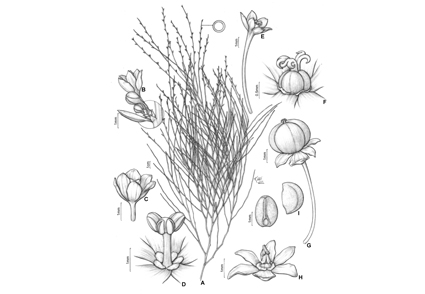Abstract
We describe Phyllanthus chapadensis, a new phyllocladiferous species of the genus Phyllanthus probable endemic to the Chapada dos Veadeiros region, Goiás, Brazil, in the Cerrado region. This region is located in Central Brazil with a high number of endemic Angiosperms, unique landscapes, and distinct and peculiar phytophysiognomies. The species described here belongs to Phyllanthus sect. Choretropsis, a Brazilian exclusive group of plants characterized by presenting phylloclades. The new species resembles P. spartioides and P. sarothamnoides, which occur in the Chapada Diamantina, Bahia, Northeastern Brazil, due to its upright shrubby habit, with thin and delicate phylloclades. However, it can be differentiated by the morphological characteristics of phylloclades and flowers. We present the main morphological distinctions between these species, distribution map, illustrations, flowering and fruiting seasons, and a proposal of the conservation status of the new species.
References
Baillon, M.H. (1858) Étude Génerale du Groupe des Euphorbiacée. Victor Masson, Paris, 684 pp.
Bouman, R.W., Ke?ler, P.J.A., Telford, I.R.H., Bruhl, J.J. & Welzen, P.C. van. (2018) Subgeneric delimitation of the plant genus Phyllanthus (Phyllanthaceae). Blumea 63: 167?198. https://doi.org/10.3767/blumea.2018.63.02.14
Bouman, R.W., Ke?ler, P.J.A., Telford, I.R.H., Bruhl, J.J., Strijk, J.S., Saunders, R.M.K. & Welzen, P.C. van. (2021) Molecular phylogenetics of Phyllanthus sensu lato (Phyllanthaceae): Towards coherent monophyletic taxa. Taxon 70: 72?98. https://doi.org/10.1002/tax.12424
Font Quer, P. (2000) Diccionario de Botánica. Ediciones Península, Barcelona, 1080pp.
Forster, J.R. & Forster, G. (1776) Characteres Generum Plantarum (second edition). Prostant apud B. White, T. Cadell, & P. Elmsly, London, pp. 113?114 & 145?146.
Govaerts, R. & Radcliffe-Smith. (1996) New names and combinations in Euphorbiaceae: Phyllanthoïdeae. Kew Bulletin 51: 175?178. https://doi.org/10.2307/4118755
IUCN (2019) Guidelines for Using the IUCN Red List Categories and Criteria. Version 14. Prepared by the Standards and Petitions Subcommittee. Available from: http://cmsdocs.s3.amazonaws.com/RedListGuidelines.pdf (accessed 10 March 2021)
Linnaeus, C. (1753) Species Plantarum. Laurentius Salvius, Stockholm, 1200pp.
Mueller, F.J.H. (1858) Fragmenta Phytogeograficae Australiae. Auctoritate Gubern. Coloniae Victoriae, ex Officina Joannis Ferres, Melbourne 1: 32?33. https://doi.org/10.5962/bhl.title.116758
Müller Argoviensis, J. (1863) Euphorbiaceae. Vouläufige Mittheifungen aus dem für De Candolle’s Prodromus bestimanten Manuscript über dieses Familiae. Linnaea 32: 1?786.
Orlandini, P., Torres, A.M., Mendes, J.C.R. & Silva, M.J. (2020a) Phyllanthus in Flora do Brasil 2020. Jardim Botânico do Rio de Janeiro. Available from: http://floradobrasil.jbrj.gov.br/reflora/floradobrasil/FB24160 (accessed 8 March 2021)
Orlandini, P., Cordeiro, I., Campos-Rocha, A. & Souza, V.C. (2020b) A new species of Phyllanthus L. (Phyllanthaceae) with phylloclades from Minas Gerais, Brazil. Phytotaxa 455: 167?172. https://doi.org/10.11646/phytotaxa.455.2.8
Orlandini, P., Cordeiro, I., Mendes, J.C.R., Campos-Rocha, A. & Souza, V.C. (2021) A new species of phyllocladiferous Phyllanthus (Phyllanthaceae) from the Atlantic Rain Forest. Systematic Botany 46: 1011–1015. https://doi.org/10.1600/036364421X16370109698669
Pax, F. & Hoffmann, K. (1923) Euphorbiaceae americanae novae In: Fedde, F. (Ed.) Repertorium specierum novarum regni vegetabilis 19 (11–13): 174–177. https://doi.org/10.1002/fedr.19230191104
Quantum GIS Development Team. (2017) Quantum GIS Geographic Information System. Open Source Geospatial Foudation Project. Available from: https://www.qgis.org/en/site/ (accessed 11 January 2022)
Radford, A.E., Dickison, W.C., Massey, J.R. & Bell, C.R. (1974) Vascular Plant Systematics. Harper and Row, New York, Evanston, San Francisco and London.
Ribeiro, J.F. & Walter, B.M.T. (1998) Fitofitofisionomias do Bioma Cerrado. In: Sano, S.M. & Almeida, S.P. (Eds.) Cerrado: ambiente e flora. Brasília: Embrapa, pp. 89–166.
Santiago, L.J.M. (1988) Estudos preliminares da seção Choretropsis Muell.Arg., gênero Phyllanthus (Euphorbiaceae). Bradea 5: 44–49.
Santiago, L.J.M., Louro, R.P. & Emmerich, M. (2006) Phyllanthus section Choretropsis (Euphorbiaceae) in Brazil. Botanical Journal of the Linnean Society 150: 131?164. https://doi.org/10.1111/j.1095-8339.2006.00459.x
Thiers, B. (2021 [continuously updated]) Index Herbariorum: a global directory of public herbaria and associated staff. The New York Botanical Garden, New York. Available from: http://sweetgum.nybg.org/science/ih/ (accessed 10 March 2021)
Webster, G.L. (1956a) Studies on the Euphorbiaceae, Phyllanthoideae II. The American species of Phyllanthus described by Linnaeus. Journal of The Arnold Arboretum 37 (1): 1–14. https://doi.org/10.5962/p.185991
Webster, G.L. (1956b) A monographic study of the West Indian species of Phyllanthus. Journal of The Arnold Arboretum 37: 91?122. https://doi.org/10.5962/p.324651
Webster, G.L. (1956c) A monographic study of the West Indian species of Phyllanthus. Journal of The Arnold Arboretum 37: 217?256. https://doi.org/10.5962/bhl.part.25737
Webster, G.L. (1956d) A monographic study of the West Indian species of Phyllanthus. Journal of The Arnold Arboretum 37: 340?357. https://doi.org/10.5962/p.324654
Webster, G.L. (1958) A monographic study of the West Indian species of Phyllanthus. Journal of The Arnold Arboretum 39: 111?212. https://doi.org/10.5962/bhl.part.19111
Webster, G.L. (1967) The genera of Euphorbiaceae in the Southeastern United States. Journal of the Arnold Arboretum 48: 332?240. https://doi.org/10.5962/p.185727


